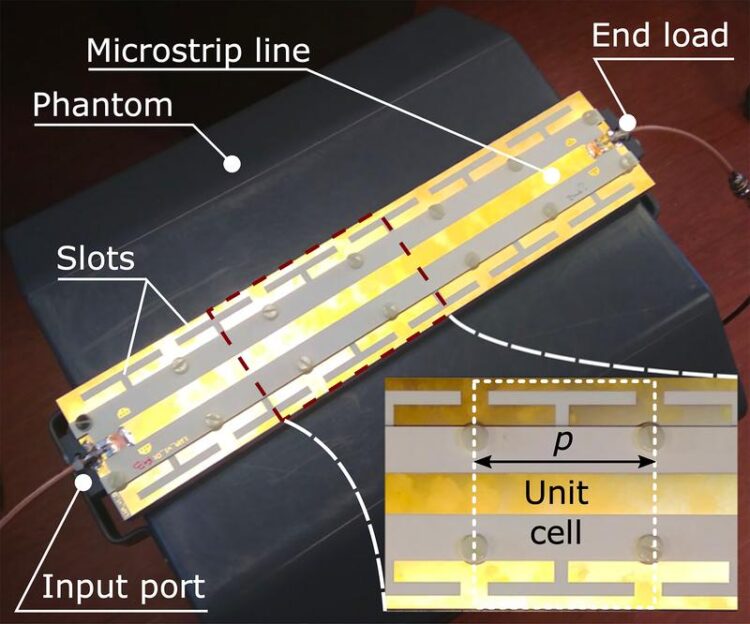New Antenna for MRI is an All-round Talent

The leaky wave antenna is built of periodic metamaterial structures.
D. Erni / UDE/ATE
Anyone needing a tomography gets the clearest possible images of an organ or other body structure slice by slice. But the further inside the potential problem lies, the more difficult it is to obtain high-resolution images in magnetic resonance imaging. An international team of scientists led by the University of Duisburg-Essen (UDE) has developed a high-frequency coil that allows for much better range inside the body – among other advantages. The scientific journal “Nature Communications” covers the topic.
Magnetic resonance imaging (MRI) at 7 tesla is the latest generation of this technology and offers images with a significantly higher-resolution than the classic devices, working with a maximum magnetic flux density of 3 tesla. However, the high-frequency magnetic fields at 7 tesla in particular are strongly absorbed by body tissue and therefore only poorly reach organs that are located far inside, such as the heart or prostate.
Long range, thereby broadband and efficient
Dr. Jan Taro Svejda from the Department of General and Theoretical Electrical Engineering (ATE) and the Center for Nanointegration (CENIDE) – together with colleagues from the ITMO University of St. Petersburg (Russia), the Technical University of Eindhoven and the University Hospital of Utrecht (both in the Netherlands) – has developed a new high-frequency coil with three decisive properties: The composite made of periodic metamaterial structures directs the energy into the radiated magnetic field as effectively as possible. This avoids an intense magnetic field directly around the antenna – and thus also on the body under examination. At the same time, this leads to a greater range because less energy is absorbed by the tissue.
The third advantage comes with the possibilities offered by this new type of leaky wave antenna: Conventional MRI antennas excite the resonance of hydrogen atomic nuclei in the body. Cartilage, however, could be better represented using the resonance of sodium nuclei, for example; but to date, this would require a different antenna with the appropriate operating frequency. “Our coil, on the other hand, can also generate such alternative magnetic resonances,” Svejda explains. “In other words, complementary MRI images, which additionally highlight tissue structures containing sodium, such as cartilage, can be produced with only one antenna.”
As a next step, the team is now working on a new version of the metamaterial structure that can further enhance the image quality from inside the body.
Editor: Birte Vierjahn, +49 203/37 9-8176, birte.vierjahn@uni-due.de
Wissenschaftliche Ansprechpartner:
Prof. Dr. sc. techn. Daniel Erni, General and Theoretical Electrical Engineering (ATE), +49 203/37 9- 4212, daniel.erni@uni-due.de
Originalpublikation:
G. Solomakha, J. T. Svejda, C. van Leeuwen, A. Rennings, A. J. Raaijmakers, S. Glybovski, D. Erni
“A self-matched leaky-wave antenna for ultrahigh-field MRI with low specific absorption rate,”
Nat. Commun., vol. 9, article no. 455, pp. 1-11, Jan. 19, 2021
DOI: 10.1038/s41467-020-20708-w
Media Contact
All latest news from the category: Power and Electrical Engineering
This topic covers issues related to energy generation, conversion, transportation and consumption and how the industry is addressing the challenge of energy efficiency in general.
innovations-report provides in-depth and informative reports and articles on subjects ranging from wind energy, fuel cell technology, solar energy, geothermal energy, petroleum, gas, nuclear engineering, alternative energy and energy efficiency to fusion, hydrogen and superconductor technologies.
Newest articles

Properties of new materials for microchips
… can now be measured well. Reseachers of Delft University of Technology demonstrated measuring performance properties of ultrathin silicon membranes. Making ever smaller and more powerful chips requires new ultrathin…

Floating solar’s potential
… to support sustainable development by addressing climate, water, and energy goals holistically. A new study published this week in Nature Energy raises the potential for floating solar photovoltaics (FPV)…

Skyrmions move at record speeds
… a step towards the computing of the future. An international research team led by scientists from the CNRS1 has discovered that the magnetic nanobubbles2 known as skyrmions can be…





















